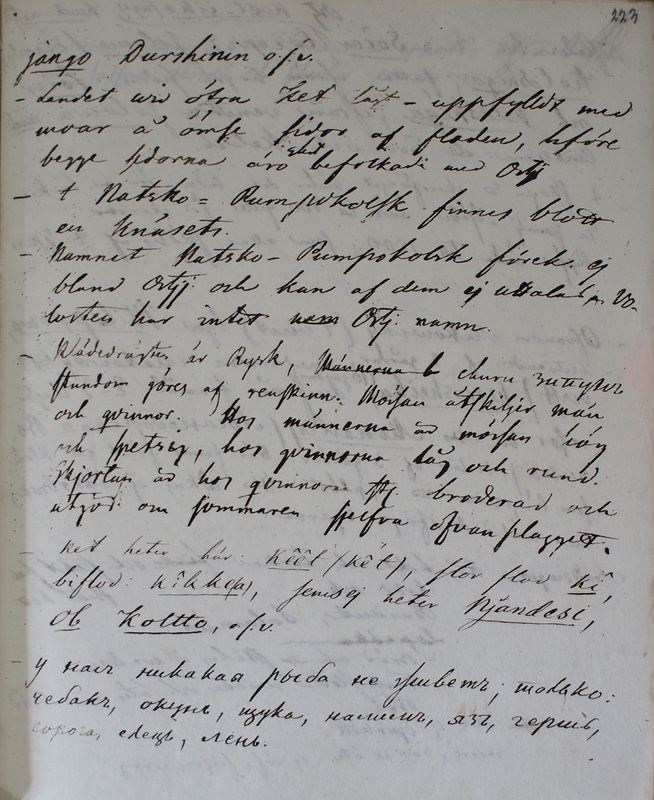Ethnographiska, historiska och statistiska anmärkningar. 223
Title
Ethnographiska, historiska och statistiska anmärkningar. 223
Description
| jango Durshinin o.s.v. |
jango Durshinin, etc. |
| Landet wid öfra Ket lågt- uppfylldt med moar å ömse sidor af floden, hföre[härföre] begge sidorna äro befolkade med Ostj. |
The land on the lower reaches of the Ket is low and filled with moors on both sides of the river, which is why both sides are populated with Ostyaks. |
| I Natsko=Pumpokolsk finnes blott en knäsets.
[knjazhestvo]Western Siberia was divided into indigenous principalities that dated back to the times of Mongol colonisation. As noted by Miller, both Nackaja (or Kadyškaja) and Pumpokolʹsk were centres of principalities before they were merged in in the beginning of 17th century. See [knjaz] (Miller 1941: 44).
|
In Natsko-Pumpokolsk there is only one principality. |
| Namnet Natsko-Pumpokolsk förek[ommer]. ej bland Ostjj.[Ostjaker] och kan af dem ej uttalalad. Vo- losten har intet Ostj.[Ostjakist] namn. |
The name Natsko-Pumpokolsk does not occur among the Ostyaks and cannot be pronounced by them. The volost has no Ostyak name. |
| Kläderägten är Rysk,
churu зипунъ
SE čī̮nəľ mi̮. See [MC Ostiak-Samoiedica’s vocabulary] A zipun is a dress made of fabric or reindeer skin and worn by both women and men. For an overview of Selkup clothing, see Tučkova 2005a: 342–347).
stundom göres af renskinn. Mössan åtskiljer män och qvinnor. Hos männerna är mössan hög och spetsig, hos qvinnorna låg och rund. Skjortan är hos qvinnorna stl. [stiligt] broderad och utgör om sommaren sjelfva ofvan plagget. |
The clothing is Russian. Churu ‘zipunʹʹ is sometimes made of reindeer skin. The hat separates men and women. Men’s hats are high and pointed, women’s low and round. Women’s shirts are embroidered in style and during summer, they form the upper garment. |
| Ket heter här Kêêt (Kêt), stor flod Kî, biflod Kîkke(a), Jenisej heter Njándesi, Ob Koltto, o.s.v. у насъ никакая рыба не живетъ, только: чебакъ окунь, щука, налимъ, язъ, гершь, сорога, елець, лень. |
The Ket is here called the Kêêt (Kêt), a large river Kî, a tributary Kîkke (a), the Yenisei is called Njándesi, the Ob is called the Koltto, etc. We do not have any fish, only: roach, perch, pike, burbot, ide, geršʹ, soroga, common dace, lenʹ. |

